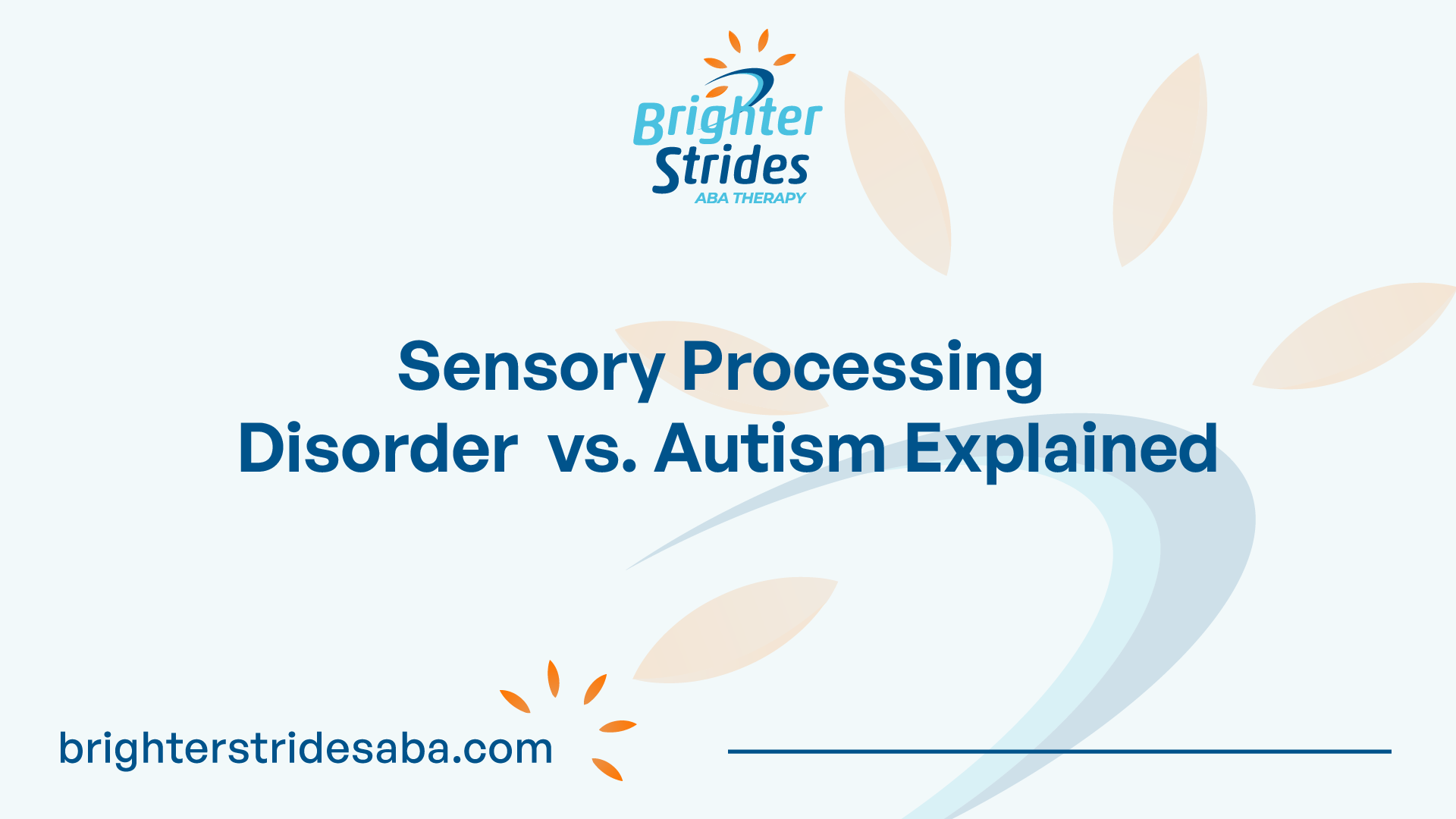Understanding Sensory Processing Disorder
Sensory Processing Disorder (SPD) is a condition that affects the way the brain processes and responds to sensory information from the environment. This can include stimuli such as sound, light, touch, taste, and smell. Individuals with SPD may have difficulty detecting, modulating, and interpreting sensory stimuli, which can significantly impact their daily routines.

Definition and Overview
SPD, also known as sensory integration dysfunction, is commonly observed in children, although it can also affect adults. It is important to note that while SPD is not recognized as a diagnosis by psychiatrists, it is acknowledged that children can have sensory issues based on over- or under-receptivity of their senses.
People with SPD experience challenges in responding to sensory input in an appropriate manner. They may exhibit oversensitivity (reacting too much) or undersensitivity (reacting too little) to sensory stimulation. This difficulty in processing sensory information can affect various aspects of their lives, including behavior, motor skills, attention, and focus.
Prevalence in the Population
The prevalence of SPD in the population is not precisely known, as it can be challenging to diagnose and often coexists with other conditions such as autism spectrum disorder (ASD), developmental delays, ADHD, or OCD. However, it is commonly observed in children and is estimated to affect approximately 5-16% of school-aged children. It is important to note that SPD can also occur in adults, although it may go undiagnosed in many cases.
Understanding the definition and prevalence of SPD sets the foundation for exploring the differences and overlaps between sensory processing disorder and autism spectrum disorder in the subsequent sections of this article.
Sensory Processing Disorder vs. Autism
When discussing sensory processing disorder (SPD) and autism spectrum disorder (ASD), it’s important to understand the differences and similarities between the two conditions.
Differentiating Between the Two
While sensory processing disorder and autism spectrum disorder share similarities and connections, they are not the same. Sensory processing disorder is often a comorbid symptom of ASD, but not all children with sensory processing disorder have autism. Sensory processing disorder is commonly seen in developmental conditions like autism spectrum disorder, although it is not recognized as a distinct medical diagnosis and is not considered a stand-alone disorder.
Shared Characteristics and Overlaps
Many children with autism spectrum disorder also experience sensory processing issues. In fact, over 80% of children with autism have sensory processing disorder, as listed in the Diagnostic and Statistical Manual of Mental Disorders (DSM-5). However, it’s important to note that most children with sensory processing disorder do not have autism.
Research has identified differences between children with autism spectrum disorder and sensory processing disorder. Children with ASD tend to score higher on Sensory Under-Reactivity and Systemizing Quotient, while children with SPD score higher on Sensory Over-Reactivity. Additionally, there are differences in brain connectivity between the two groups [5].
To better understand the overlap and distinctions between ASD and SPD, healthcare professionals, including doctors with expertise in developmental and behavioral concerns, mental health professionals, and occupational therapists, play a crucial role in diagnosis and evaluation [4]. The diagnosis process may involve observing physical attributes, coordination, eye movements, balance, and responses to sensory stimuli.
While sensory processing disorder may commonly co-occur with autism spectrum disorder, it is essential to recognize that sensory processing issues can also occur in individuals with other developmental and learning delays, ADHD, OCD, or even without any other diagnosis. Understanding these differences and similarities helps professionals tailor therapeutic interventions and strategies to address the specific needs of individuals with sensory processing difficulties.
Causes and Neurological Connections
When exploring the causes and neurological connections of sensory processing disorder (SPD) and autism, it becomes clear that there are shared characteristics and overlaps between the two conditions. Understanding the underlying factors can provide valuable insights into these neurodevelopmental disorders.
Brain Function and Processing
Sensory processing disorder occurs when sensory information entering the nervous system is incorrectly processed, leading to inaccurate reactions, recognition, perceptions, or awareness. The brain plays a crucial role in this process, as it interprets and integrates sensory input from the environment.
Research has shown that there are differences in brain connectivity and functioning between individuals with autism spectrum disorder (ASD) and sensory processing disorder (SPD). Children with ASD tend to exhibit higher scores on Sensory Under-Reactivity and Systemizing Quotient, while children with SPD tend to have higher scores on Sensory Over-Reactivity. These differences in sensory processing can contribute to the unique challenges experienced by individuals with these conditions.
Genetic Components and Inheritance
Both sensory processing disorder and autism spectrum disorder have genetic components that contribute to their development. Studies have shown shared abnormalities in the gray or white matter of the brain responsible for sensory processing, which may explain why ASD often co-occurs with SPD. Additionally, data suggests that about 90% of individuals with ASD also have SPD [1]. This indicates a strong association between the two conditions and further supports the genetic link.
It’s important to note that sensory processing disorder can also be associated with other factors such as premature birth, brain injury, learning disorders, and attention deficit hyperactivity disorder (ADHD). These additional factors can contribute to the occurrence of sensory processing disorder independently or in conjunction with other neurodevelopmental disorders.
Understanding the causes and neurological connections of sensory processing disorder and autism provides valuable insights into the complex nature of these conditions. While there are shared characteristics and overlaps, further research is needed to fully comprehend the intricacies of these disorders and develop effective interventions for individuals affected by them.
Diagnosis and Evaluation
When it comes to diagnosing sensory processing disorder (SPD) and autism, the involvement of healthcare professionals is crucial. Through a comprehensive evaluation process, experts can assess the individual’s symptoms, behavior, and sensory responses to make an accurate diagnosis.
Healthcare Professionals Involved
The diagnosis of sensory processing disorder and autism involves a multidisciplinary approach, with various healthcare professionals playing a key role in the evaluation process. These professionals may include:
- Doctors with expertise in developmental and behavioral concerns: These doctors are trained to identify and assess the signs and symptoms associated with sensory processing disorder and autism. They can conduct physical examinations, observe the individual’s behavior and sensory responses, and gather information about their developmental history.
- Mental health professionals: Psychologists, psychiatrists, or other mental health professionals may be involved in the evaluation process. They can administer psychological tests, assess behavioral patterns, and evaluate the individual’s emotional well-being.
- Occupational therapists (OTs): OTs specialize in evaluating sensory processing difficulties and their impact on daily functioning. They can assess how an individual processes and responds to sensory stimuli and provide valuable insights into the diagnosis of sensory processing disorder.
Diagnostic Criteria and Assessment
To diagnose sensory processing disorder and differentiate it from other conditions, healthcare professionals rely on specific diagnostic criteria and assessments. These criteria and assessments may vary depending on the professional and the diagnostic framework used.
During the evaluation process, professionals may consider the following factors:
- Behavioral observations: Professionals may observe the individual’s physical attributes, coordination, eye movements, balance, and responses to sensory stimuli. These observations help in identifying potential sensory processing difficulties.
- Developmental history: Gathering information about the individual’s developmental milestones, early behaviors, and any known risk factors can provide valuable insights into their sensory processing abilities.
- Parent and caregiver interviews: Interviews with parents or caregivers play a crucial role in understanding the individual’s behavior, sensory responses, and overall functioning in different environments.
- Questionnaires and standardized assessments: Professionals may use specific questionnaires and standardized assessments to gather more detailed information about the individual’s sensory processing abilities and challenges. These assessments can help in quantifying sensory responses and identifying patterns of sensory processing difficulties.
By combining the expertise of different healthcare professionals and utilizing various diagnostic criteria and assessments, an accurate diagnosis of sensory processing disorder or autism can be made. This diagnosis is essential for developing appropriate interventions and support strategies to help individuals effectively manage their sensory differences.
Therapeutic Interventions
When it comes to addressing sensory processing disorder (SPD) and autism, various therapeutic interventions can help individuals manage their sensory differences and improve their overall well-being. Two commonly utilized interventions are sensory integration therapy and occupational therapy approaches.
Sensory Integration Therapy
Sensory integration therapy, often led by occupational therapists or physiotherapists, is a frequently recommended treatment for children with sensory processing disorder. This therapy is based on the work of A. Jean Ayres, an occupational therapist who expanded on the traditional five senses by adding two additional senses: body awareness (proprioception) and movement (vestibular).
The goal of sensory integration therapy is to help individuals with sensory processing difficulties learn how to properly respond to sensory input by engaging them in activities that provide the appropriate amount of sensory stimulation. These activities may include deep touch pressure, games that involve physical interaction, or the use of weighted objects to increase body awareness and spatial understanding.
Sensory integration therapy involves a complex evaluation of each individual to determine their sensory defensiveness and sensory cravings. Occupational therapists use specialized equipment in sensory gyms for treatment, which may include swings, weighted vests, squeeze machines, and brushes. Techniques such as brushing, known as the Wilbarger protocol, provide deep pressure and are followed by joint compressions. Other therapeutic approaches used in sensory integration therapy include listening programs and Astronaut Training. Treatment is often carried out within a sensory diet, consisting of specific therapies and adaptations to the home environment.
While sensory integration therapy has been reported to be effective in improving problem behaviors associated with sensory processing disorder, it is important to note that it has not been extensively studied. However, many families report positive outcomes and improved functioning after undergoing this therapy.
Occupational Therapy Approaches
Occupational therapy (OT) approaches are also commonly employed to address sensory processing issues in individuals with sensory processing disorder and autism. Occupational therapists play a crucial role in evaluating and providing intervention to help individuals develop the necessary skills for everyday activities.
OT approaches focus on developing strategies to enhance sensory processing skills and improve overall functioning. These approaches often include a combination of therapeutic activities, environmental modifications, and skill-building techniques. Occupational therapists collaborate with caregivers to create individualized treatment plans that target specific areas of difficulty.
The specific interventions used in occupational therapy may vary depending on the individual’s needs. Some common approaches include sensory-based strategies, cognitive-behavioral techniques, social skills training, and adaptive equipment recommendations. The therapy may involve activities designed to improve sensory modulation, motor coordination, self-regulation, and adaptive behaviors.
Occupational therapists also work closely with individuals and their families to identify sensory triggers and develop coping strategies. They may provide guidance on creating sensory-friendly environments at home, school, or work. By addressing sensory challenges and promoting self-regulation, occupational therapy aims to enhance individuals’ participation in daily life activities.
Both sensory integration therapy and occupational therapy approaches can play significant roles in helping individuals with sensory processing disorder and autism manage their sensory differences and improve their quality of life. These interventions, when implemented by trained professionals, offer valuable tools and strategies to address sensory challenges and promote optimal functioning.
Managing Sensory Differences
Individuals with sensory processing differences, whether they have sensory processing disorder or autism, may benefit from various strategies to manage their unique sensory needs. Making environmental adjustments and implementing strategies in daily life can help create a more comfortable and supportive sensory experience.
Environmental Adjustments
Creating an environment that accommodates sensory differences can significantly improve the well-being of individuals with sensory processing differences. Some environmental adjustments that can be beneficial include:
- Lighting: Reduce or modify fluorescent lighting, which can be overwhelming for some individuals. Providing sunglasses or using natural lighting can help manage hypersensitivity to light.
- Visual Distractions: Create a workstation or designated space with high walls to block visual distractions, allowing individuals to focus on tasks without being overwhelmed by their surroundings.
- Noise: Position individuals away from noisy areas and provide earplugs or noise-cancelling headphones to manage auditory sensitivities. Preparing individuals for noisy environments and using visual supports to reinforce verbal information can also be helpful.
- Touch: Offer sensory supports, such as latex-free tubes for chewing or weighted blankets, to assist individuals with touch sensitivities. Creating a calm and soothing environment with soft textures and comfortable seating can also be beneficial.
- Balance: Encourage activities that provide sensory input for the vestibular system, such as swinging or catching a ball. These activities can help individuals with balance sensitivities develop better control over their movements.
Strategies for Daily Life
Implementing strategies in daily life can help individuals with sensory processing differences manage their sensory needs effectively. Some strategies to consider include:
- Sensory Profiles: Create a sensory profile for the individual, identifying their specific sensory preferences and sensitivities. This allows for a better understanding of their needs and helps in tailoring interventions accordingly.
- Sensory Breaks: Incorporate regular sensory breaks throughout the day to provide individuals with opportunities to self-regulate and manage sensory overload. These breaks can include calming activities, such as deep breathing exercises, listening to calming music, or engaging in sensory play.
- Visual Supports: Use visual supports to reinforce verbal information, aid in communication, and provide visual structure and predictability. Visual schedules, social stories, and visual cues can help individuals better understand and navigate their daily routines.
- Calming Strategies: Teach and encourage the use of calming strategies, such as deep pressure techniques, mindfulness exercises, or engaging in preferred activities, to help individuals regulate their sensory experiences.
By implementing environmental adjustments and strategies for daily life, individuals with sensory processing differences can navigate their sensory challenges more effectively. It’s important to remember that each person’s sensory needs may vary, so it’s essential to tailor these strategies to the individual’s specific preferences and sensitivities. Regular communication and collaboration with healthcare professionals and therapists can provide valuable guidance and support in managing sensory differences.
References
- https://www.medicalnewstoday.com/articles/sensory-processing-disorder-vs-autism
- https://www.webmd.com/children/sensory-processing-disorder
- https://childmind.org/article/treating-sensory-processing-issues/
- https://www.columbiadoctors.org/health-library/condition/sensory-processing-disorder/
- https://www.autismparentingmagazine.com/autism-sensory-processing-disorder/
- https://www.ivyrehab.com/news/sensory-processing-vs-autism-whats-the-difference/
- https://www.healthlinkbc.ca/health-topics/sensory-processing-disorder
- https://www.autism.org.uk/advice-and-guidance/topics/sensory-differences/sensory-differences/all-audiences




